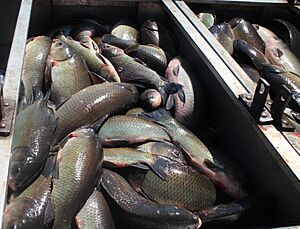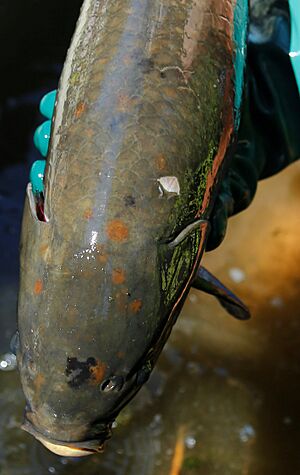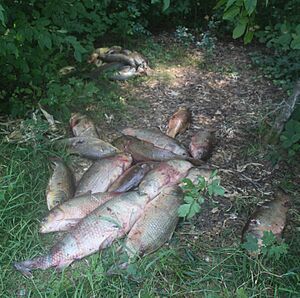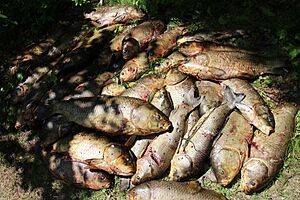Bigmouth buffalo facts for kids
The bigmouth buffalo is a special fish from North America. Its scientific name is Ictiobus cyprinellus. It is the biggest fish in North America from the "sucker" family. This amazing fish can live for a very, very long time – up to 127 years! Even when they are 100 years old, they are still strong and healthy, which makes them a biological marvel. People call this fish by many names, like gourdhead, marblehead, or buffalofish. The bigmouth buffalo is not a carp, even though they look a bit similar. They are from different groups and different parts of the world.
Quick facts for kids Bigmouth buffalo |
|
|---|---|
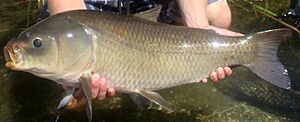 |
|
| Bigmouth buffalo male | |
| Conservation status | |
| Scientific classification | |
| Synonyms | |
|
Bigmouth buffalo fish are usually brownish-olive with dark fins. But their colors can change a lot! Some can be very dark, golden, or even yellowish. Like other sucker fish, they have a long dorsal fin (the fin on their back). What makes them unique is their mouth, which faces forward. This helps them eat tiny things floating in the water. They are the largest of the buffalofishes. They can grow to be over 4 feet (1.2 meters) long and weigh more than 80 pounds (36 kg). They usually live in lakes or slow parts of big rivers. Sadly, the number of bigmouth buffalo has been going down in the northern parts of their home since the 1970s. This includes places like Minnesota, North Dakota, and Canada.
Scientists found out in 2019 that these fish live for a very long time and start having babies late in life. In some areas, most of the fish (85-90%) are over 80 years old! This means not many young fish have joined the population since the 1930s. This new information changed what people thought about this fish. More studies in 2021 and 2022 showed that bigmouth buffalo grow slowly. They have babies only sometimes, and their populations are shrinking. These traits make them very sensitive to too much fishing, damaged homes, and invasive species. Bigmouth buffalo are declining in Canada and the US. This decline is linked to a type of fishing called bowfishing where fish are sometimes not used. These fish can survive for many decades even without new young fish joining the group. This is more than other long-lived fish like sturgeon. They need time to survive until good conditions appear for them to have many babies. Fishing that is not managed well can harm them. Canada has rules to protect bigmouth buffalo.
Contents
Where Bigmouth Buffalo Live
The bigmouth buffalo naturally lives in Canada and the United States. You can find them in the Red River of the North and Mississippi River systems. This stretches from Manitoba, Canada, and North Dakota, United States, all the way south to the Ohio River and down to Texas and Alabama.
In Canada, they live in the Milk River in Alberta. They also live in the Qu'Appelle River which flows through Saskatchewan and Manitoba into Lake Winnipeg. In the northern US, they are found in Montana, North Dakota, Minnesota, and Wisconsin. They also live in southern states like eastern Texas, Oklahoma, and Louisiana. Their main homes are in the Hudson Bay and Mississippi River areas.
Sometimes, bigmouth buffalo have been moved to new places for fishing. This includes some lakes along the Missouri River in North Dakota and Montana. They have also been introduced to reservoirs in Arizona. In California, they were brought into the water system of Los Angeles.
Importance of Bigmouth Buffalo
Bigmouth buffalo are a very important part of the natural world in North America. When they are young, they are food for other fish like walleye, northern pike, and catfish. Bigmouth buffalo also help clean the water. They eat tiny baby zebra mussels, which are an invasive species. They are like the native version of the bighead and silver carp, which are also invasive. Bigmouth buffalo also compete with the common carp, another invasive fish. But these invasive fish are often better at competing than the native bigmouth buffalo.
Native Americans used bigmouth buffalo for food. The famous explorers Lewis and Clark also caught them in 1804. People have valued them as a good fish to catch for food since the 1800s. They are a popular food fish in parts of the United States. Fishers need special permits to catch them. They report their catches to the state. The fish are kept alive in tanks and taken to markets. They are often eaten as "buffalo ribs" in Arkansas. Even though they have small bones, they taste good. This makes them one of the most valuable non-game freshwater fish.
Recently, bigmouth buffalo have also become popular for sport fishing. Anglers now try to catch them with a rod and line and then release them. However, a type of fishing called bowfishing has also grown. In this type of fishing, fish are shot with a bow and arrow. While commercial fishing is managed, sport-kill bowfishing is not always regulated.
Ecology and Life Cycle
The bigmouth buffalo plays a special role in shallow water areas. When they are very young, they eat tiny creatures like copepods and cladocerans. They also eat tiny plants and insect larvae. Unlike their relatives, the black and smallmouth buffalos, bigmouth buffalo are filter-feeders. This means they use special parts in their gills to strain tiny plankton from the water. They sometimes feed near the bottom, taking in plankton that are floating there. Older young fish and adults mostly eat plankton floating in the water. They also eat cladocerans, copepods, algae, and insect larvae.
The best place for bigmouth buffalo to have babies is in freshly flooded areas with lots of plants. They are tough fish that can live in cloudy water and water with low oxygen. They can be found in water that is very murky. They prefer slow-moving water. The water temperature for their eggs to hatch is best between 15-18 degrees Celsius (59-64 degrees Fahrenheit).
Reproduction
Bigmouth buffalo lay many eggs in groups. A female can lay about 250,000 eggs for every kilogram of her body weight. Their eggs are very small, about 1.5 mm wide. They usually lay eggs in spring, between April and June. This happens when the water temperature is between 13 and 26 degrees Celsius (55-79 degrees Fahrenheit). But they might not lay eggs if the water levels are not right. They lay sticky eggs in areas with lots of plants. Females look for plants that are under or sticking out of the water. These are ideal spots for their eggs to hatch. Water levels need to rise a lot before they lay eggs.
Salty water can be a problem for them to have babies. They can lay eggs in slightly salty water. But their eggs and young fish cannot survive in water that is too salty. The water also needs enough oxygen. More than one male fish will help a female lay eggs. They move the female to the top of the water to help mix the eggs and sperm.
Amazing Longevity
The bigmouth buffalo holds an amazing record! It can live up to 127 years. This makes it the longest-living freshwater fish known. It lives more than 50 years longer than any other freshwater fish in its group. Before 2019, people thought this fish only lived for about 26 years. So, when scientists found out how long they really live, it was a big surprise! They used a special method called "bomb radiocarbon dating" to check the fish's ear bones. This confirmed their age, making the bigmouth buffalo the oldest age-validated freshwater fish in the world.
Bigmouth buffalo start having babies at different ages depending on where they live. In central North Dakota and southern Minnesota, females start having babies around 10 years old. Males start around 6 years old. In Canada, females might not start having babies until they are 11 years old or older. This late start to having babies, along with their very long lives, shows they have a slow, long life journey. As bigmouth buffalo get older, they often get unique orange and black spots. These spots can look different depending on the water quality and food in their home.
Protecting Bigmouth Buffalo
It's hard to know exactly how many bigmouth buffalo are in Canada because they haven't been studied enough. They are a "special concern" species there. Some threats to them include losing their shallow water homes where they lay eggs. This happens when rivers are changed. Also, cloudy water can make it hard for their eggs to survive. Dams also hurt them by blocking their paths to good places to lay eggs. They can also die in winter if the water gets too cold or has low oxygen. They are also very sensitive to too much fishing.
In Pennsylvania, the bigmouth buffalo is an endangered fish. In other places, it is not yet listed as threatened or endangered. However, populations in the Saskatchewan-Nelson River area have been a special concern since 2011. This is because their numbers have been going down in the northern US since the 1970s. In some parts of Minnesota, most of the fish (85-90%) hatched before 1940. But there are no limits on how many fish can be caught there. This is a problem, especially with the rise of modern night bowfishing that targets these fish. Scientists found that the increase in bowfishing happened at the same time as the bigmouth buffalo numbers went down.
Young bigmouth buffalo can get a parasite called Lernea cyprinacae. But most fish are fine once they grow bigger. The real problem is if they get a second infection because of these parasites, especially in bad water. The bigmouth buffalo has also been seen mixing with smallmouth buffalo. This means they sometimes have babies together. This doesn't seem to hurt their populations. But it makes it hard to know how many of each fish are in certain lakes.
These fish are easy to catch in shallow water, often by bow and arrow. They are also caught by commercial fishers using nets and lines. Right now, there are no specific plans in the United States to manage and protect the bigmouth buffalo. In some southern US states, young fish have been raised in special hatcheries. More attention is needed to manage bigmouth buffalo, especially in the northern US. This is where the fish are very old and their numbers are declining. In 2013, the International Union for Conservation of Nature did not think bigmouth buffalo were at risk of disappearing. But this was before scientists learned how long they really live and how sensitive they are.
Fishing Records
Bigmouth buffalo are big fish, and some impressive records have been set!
- On June 21, 2013, Noah LaBarge, who was 12 years old, caught the Wisconsin state record bigmouth buffalo. It was 49.5 inches (126 cm) long and weighed 76.5 pounds (34.7 kg). He caught it in the Wisconsin River. This fish was recognized as a new world record!
- In Mt. Juliet, Tennessee, Jeff Wilkins caught a record 62-pound (28 kg) bigmouth buffalo on March 31, 2010. It was 45 inches (114 cm) long. It took him 35 minutes to reel in the fish! After the record was confirmed, Jeff released the fish back into the lake.
- In Omaha, Nebraska, Joe Slavic caught a 64-pound (29 kg) bigmouth buffalo on June 8, 2000. He used mulberry bait.
- The world record for any type of fishing gear is 31.89 kg (70.3 lb). It was caught on April 21, 1980, by Delbert Sisk in Bastrop, Louisiana.
Images for kids



